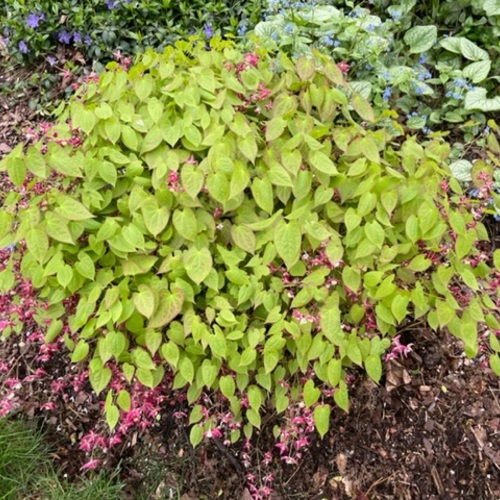Helen Rehn is welcoming us into her garden today.
I live in La Grange, Illinois, a suburb of Chicago. I used to long for a lot of sun in my garden, but I now appreciate my shade. Most of my garden lies beneath a very old English elm or a red maple. When the garden comes to life in the spring, it brings me joy.
 A pink hellebore (Helleborus hybrid, Zones 4–9) with brunnera (Brunnera macrophylla, Zones 3–8). Both of these plants have beautiful flowers, the hellebore with long-lasting blooms that start in early spring and remain lovely even as they shade into green later in the season. The brunnera’s clouds of small blue flowers don’t last as long, but they complement the hellebore perfectly. Both have attractive foliage the rest of the season as well; the hellebore sturdy and evergreen, while the brunnera unfolds large, slightly hairy, heart-shaped leaves.
A pink hellebore (Helleborus hybrid, Zones 4–9) with brunnera (Brunnera macrophylla, Zones 3–8). Both of these plants have beautiful flowers, the hellebore with long-lasting blooms that start in early spring and remain lovely even as they shade into green later in the season. The brunnera’s clouds of small blue flowers don’t last as long, but they complement the hellebore perfectly. Both have attractive foliage the rest of the season as well; the hellebore sturdy and evergreen, while the brunnera unfolds large, slightly hairy, heart-shaped leaves.
 Pink bleeding heart (Dicentra spectabilis, Zones 2–8) blooms with red Darwin tulips (Tulipa hybrid, Zones 2–7). The Darwin tulip group is one of the best for perennializing, coming back to flower year after year especially in well-drained soils and in colder climates. Next to them, healthy clumps of daylily foliage (Hemerocallis hybrid, Zones 4–9) promise abundant blooms later in the season.
Pink bleeding heart (Dicentra spectabilis, Zones 2–8) blooms with red Darwin tulips (Tulipa hybrid, Zones 2–7). The Darwin tulip group is one of the best for perennializing, coming back to flower year after year especially in well-drained soils and in colder climates. Next to them, healthy clumps of daylily foliage (Hemerocallis hybrid, Zones 4–9) promise abundant blooms later in the season.
 The lush foliage of this ‘Ivory Prince’ hellebore (Helleborus ‘Ivory Prince’, Zones 4–8) pushes out past the fading blooms. ‘Ivory Prince’ is one of the sterile hellebore hybrids, which means it won’t self-sow in the garden and tends to grow and bloom more vigorously because it doesn’t spend energy making seeds.
The lush foliage of this ‘Ivory Prince’ hellebore (Helleborus ‘Ivory Prince’, Zones 4–8) pushes out past the fading blooms. ‘Ivory Prince’ is one of the sterile hellebore hybrids, which means it won’t self-sow in the garden and tends to grow and bloom more vigorously because it doesn’t spend energy making seeds.
 Brunnera surround a newly planted Rhododendron (Zones 5–9). The brunnera at the bottom left has silver-patterned foliage, which is found in many cultivars, such as ‘Jack Frost’. When happy, brunnera self-sows, and the seedlings often vary from having green leaves to silvery leaves to lightly spotted leaves with silver in between.
Brunnera surround a newly planted Rhododendron (Zones 5–9). The brunnera at the bottom left has silver-patterned foliage, which is found in many cultivars, such as ‘Jack Frost’. When happy, brunnera self-sows, and the seedlings often vary from having green leaves to silvery leaves to lightly spotted leaves with silver in between.
 A Japanese maple (Acer palmatum, Zones 5–9) begins to leaf out in the spring.
A Japanese maple (Acer palmatum, Zones 5–9) begins to leaf out in the spring.
 The pink flowers of epimedium (Epimedium × rubrum, Zones 5–9) are beautiful in the spring, and the airy, delicate-looking foliage provides a great counterpoint to the big, bold leaves of the brunnera behind it. Despite their delicate look, epimediums are durable plants, one of the best choices for difficult dry shade conditions.
The pink flowers of epimedium (Epimedium × rubrum, Zones 5–9) are beautiful in the spring, and the airy, delicate-looking foliage provides a great counterpoint to the big, bold leaves of the brunnera behind it. Despite their delicate look, epimediums are durable plants, one of the best choices for difficult dry shade conditions.
 The clouds of blue brunnera flowers are joined by other shade-loving perennials such as variegated Jacob’s ladder (Polemonium caeruleum ‘Brise d’Anjou’, Zones 4–8) and Japanese forest grass (Hakonechloa macra, Zones 5–9).
The clouds of blue brunnera flowers are joined by other shade-loving perennials such as variegated Jacob’s ladder (Polemonium caeruleum ‘Brise d’Anjou’, Zones 4–8) and Japanese forest grass (Hakonechloa macra, Zones 5–9).
 More Darwin tulips bloom behind the dark foliage of Heuchera ‘Palace Purple’ (Zones 4–9).
More Darwin tulips bloom behind the dark foliage of Heuchera ‘Palace Purple’ (Zones 4–9).
Have a garden you’d like to share?
Have photos to share? We’d love to see your garden, a particular collection of plants you love, or a wonderful garden you had the chance to visit!
To submit, send 5-10 photos to [email protected] along with some information about the plants in the pictures and where you took the photos. We’d love to hear where you are located, how long you’ve been gardening, successes you are proud of, failures you learned from, hopes for the future, favorite plants, or funny stories from your garden.
Have a mobile phone? Tag your photos on Facebook, Instagram or Twitter with #FineGardening!
Do you receive the GPOD by email yet? Sign up here.
